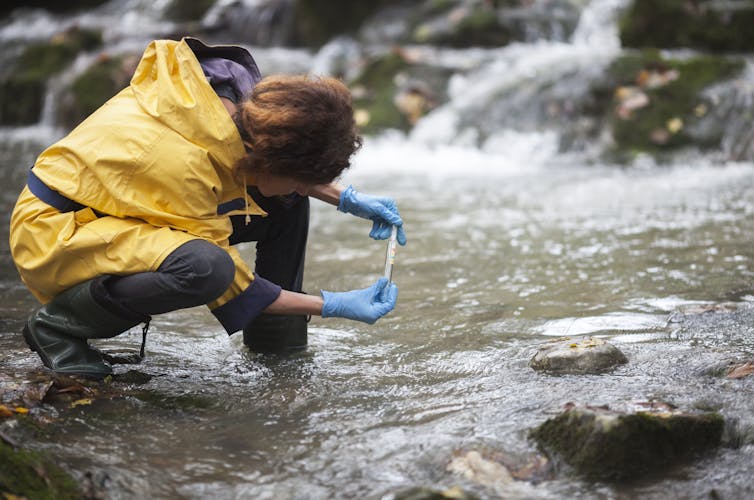
“PFAS? What’s PFAS?”
You may be hearing that term in the news as the federal government considers new rules and guidelines for the chemicals. Even if the acronym is new to you, you’re probably already familiar with what PFAS do. That’s because they’re found in everything from nonstick cookware to carpets to ski wax.
PFAS stands for per- and polyfluoroalkyl substances, which are a large group of human-made chemicals – currently estimated to be around 9,000 individual chemical compounds – that are used widely in consumer products and industry. They can make products resistant to water, grease and stains and protect against fire.
Waterproof outdoor apparel and cosmetics, stain-resistant upholstery and carpets, food packaging that is designed to prevent liquid or grease from leaking through, and certain firefighting equipment often contain PFAS. In fact, one recent study found that most products labeled stain- or water-resistant contained PFAS, and another study found that this is even true among products labeled as “nontoxic” or “green.” PFAS are also found in unexpected places like high-performance ski and snowboard waxes, floor waxes and medical devices.
At first glance, PFAS sound pretty useful, so you might be wondering “what’s the big deal?”
The short answer is that PFAS are harmful to human health and the environment.
Some of the very same chemical properties that make PFAS attractive in products also mean these chemicals will persist in the environment for generations. Because of the widespread use of PFAS, these chemicals are now present in water, soil and living organisms and can be found across almost every part of the planet, including Arctic glaciers, marine mammals, remote communities living on subsistence diets, and in 98% of the American public.
The Environmental Protection Agency recently issued new warnings about their risk in drinking water even at very low levels.
Health risks from PFAS exposure
Once people are exposed to PFAS, the chemicals remain in their bodies for a long time – months to years, depending on the specific compound – and they can accumulate over time.
Research consistently demonstrates that PFAS are associated with a variety of adverse health effects. A recent review by a panel of experts looking at research on PFAS toxicity concluded with a high degree of certainty that PFAS contribute to thyroid disease, elevated cholesterol, liver damage and kidney and testicular cancer.

Further, they concluded with a high degree of certainty that PFAS also affect babies exposed in utero by increasing their likelihood of being born at a lower birth weight and responding less effectively to vaccines, while impairing women’s mammary gland development, which may adversely impact a mom’s ability to breastfeed.
The review also found evidence that PFAS may contribute to a number of other disorders, though further research is needed to confirm existing findings: inflammatory bowel disease, reduced fertility, breast cancer and an increased likelihood of miscarriage and developing high blood pressure and preeclampsia during pregnancy. Additionally, current research suggests that babies exposed prenatally are at higher risk of experiencing obesity, early-onset puberty and reduced fertility later in life.
Collectively, this is a formidable list of diseases and disorders.
Who’s regulating PFAS?
PFAS chemicals have been around since the late 1930s, when a DuPont scientist created one by accident during a lab experiment. DuPont called it Teflon, which eventually became a household name for its use on nonstick pans.
Decades later, in 1998, Scotchgard maker 3M notified the Environmental Protection Agency that a PFAS chemical was showing up in human blood samples. At the time, 3M said low levels of the manufactured chemical had been detected in people’s blood as early as the 1970s.
Despite the lengthy list of serious health risks linked to PFAS and a tremendous amount of federal investment in PFAS-related research in recent years, PFAS haven’t been regulated at the federal level in the United States.
The EPA has issued advisories and health-based guidelines for two PFAS compounds – PFOA and PFOS – in drinking water, though these guidelines are not legally enforceable standards. And the Agency for Toxic Substances and Disease Registry has a toxicological profile for PFAS.
Federal rules could be coming. Congress is considering legislation to ban PFAS in some food packaging. The EPA has a road map for PFAS regulations it is considering, including regulations involving drinking water. The Biden administration has said it also expects to list PFOA and PFOS as hazardous substances under the Superfund law, a move that worries utilities and businesses that use PFAS-containing products or processes because of the expense of cleanup.
States, meanwhile, have been taking their own actions to protect residents against the risk of PFAS exposure.
At least 21 states have laws targeting PFAS in various uses, such as in food packaging and carpets. But relying on state laws places burdens on state agencies responsible for enforcing them and creates a patchwork of regulations which, in turn, place burdens on business and consumers to navigate regulatory nuances across state lines.
So, what can you do about PFAS?
Based on current scientific understanding, most people are exposed to PFAS primarily through their diet, though drinking water and airborne exposures may be significant among some people, especially if they live near known PFAS-related industries or contamination.
The best ways to protect yourself and your family from risks associated with PFAS are to educate yourself about potential sources of exposures.
Products labeled as water- or stain-resistant have a good chance of containing PFAS. Check the ingredients on products you buy and watch for chemical names containing “fluor-.” Specific trade names, such as Teflon and Gore-Tex, are also likely to contain PFAS.
Check whether there are sources of contamination near you, such as in drinking water or PFAS-related industries in the area. Some states don’t test or report PFAS contamination, so the absence of readily available information does not necessarily mean the region is free of PFAS problems.
For additional information about PFAS, check out the Agency for Toxic Substances and Disease Registry, EPA and U.S. Centers for Disease Control and Prevention websites or contact your state or local public health department.
If you believe you have been exposed to PFAS and are concerned about your health, contact your health care provider. The Agency for Toxic Substances and Disease Registry has a succinct report to help health care professionals understand the clinical implications of PFAS exposure.![]()
Kathryn Crawford, Assistant Professor of Environmental Health, Middlebury
This article is republished from The Conversation under a Creative Commons license. Read the original article.